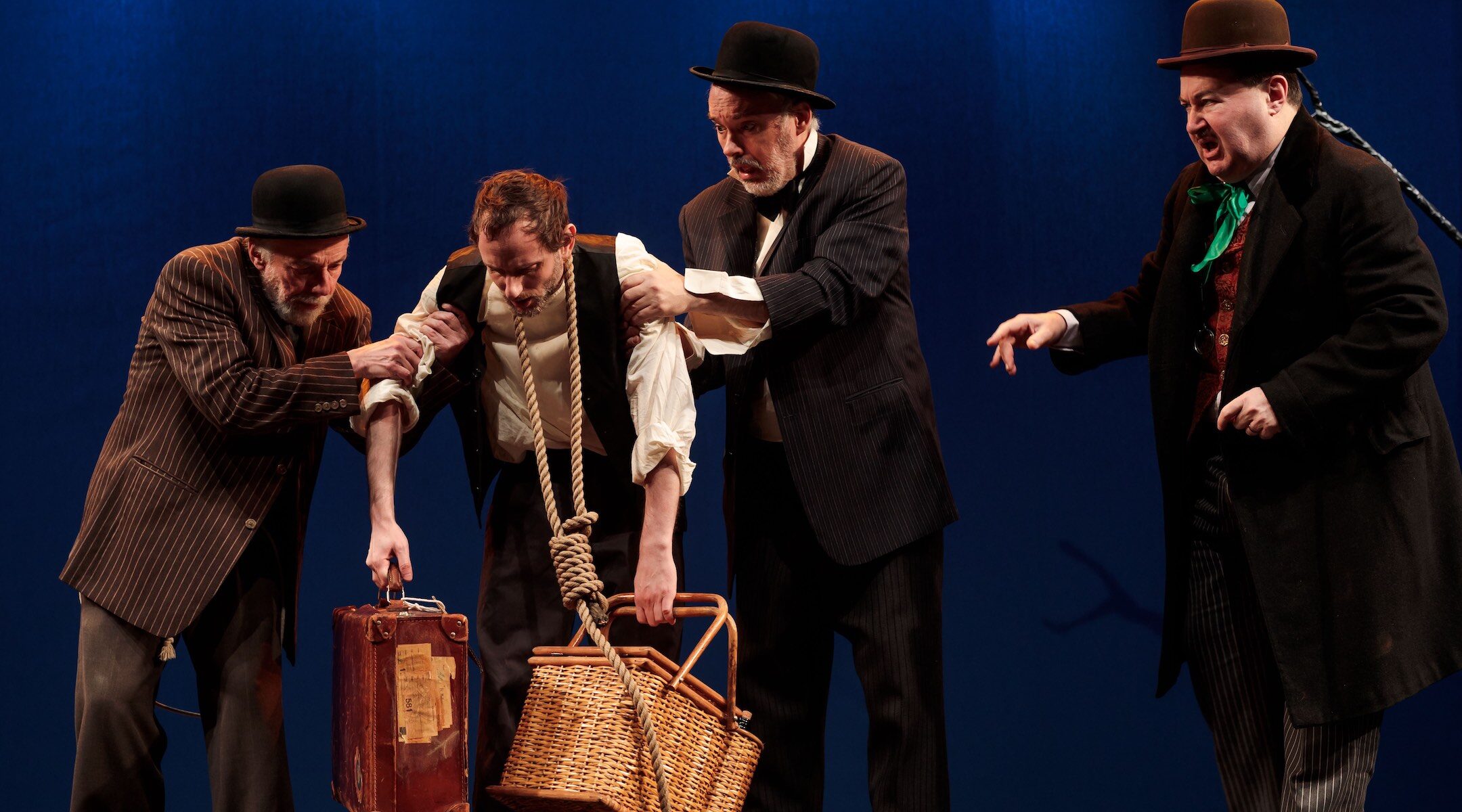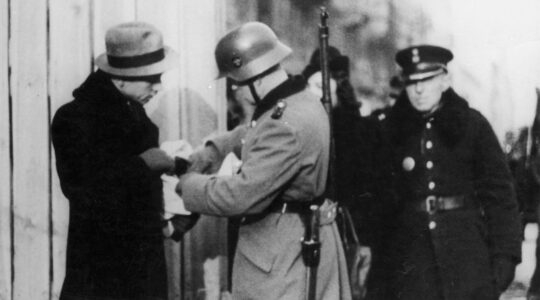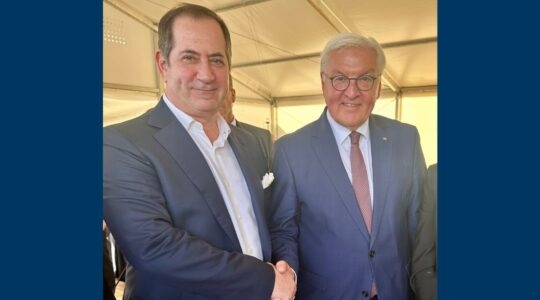STOCKHOLM (JTA) — Actors in this weekend’s production of “Waiting for Godot” at the Royal Dramatic Theater in Stockholm performed neither in the classic play’s original English nor in Swedish translation.
Rather, they were speaking Yiddish, a language spoken by few Swedes but increasingly cherished by many.
The Yiddish version of Samuel Beckett’s classic absurdist play, translated by Shane Baker, premiered in 2013 through the New Yiddish Rep, a theater company in New York City, under the direction of Moshe Yassur, a Holocaust survivor whose career in Yiddish theater dates to his prewar childhood in Romania. It has toured as far afield as Paris and Enniskillen in Northern Ireland.
The performances marked its debut in Sweden, and the first time ever that a play in Yiddish was staged at Sweden’s national theater company — the only home that its local backers considered.
“I didn’t want it anywhere else but in Dramaten,” said Lizzie Oved Scheja, the executive director of J!Jewish Culture in Sweden, one of the institutions responsible for bringing the performance to Stockholm, about the choice of the venue.
“We believe that Jewish culture should be a part of Swedish culture, and that it should be presented on all the main stages in Sweden,” she said.
The three performances were filled almost to capacity and drew prominent audience members including the Swedish minister of culture, leading Oved Scheja to characterize the staging as “a triumph of a culture that was supposed to be wiped out” in the Holocaust.
In Sweden today, no more than 3,000 people out of a Jewish population of roughly 25,000 can speak Yiddish, according to the country’s Society for Yiddish (Jiddischsällskapet). Even that figure may well be an overestimate, given the country’s small number of haredi Orthodox Jews, the population that most often speaks Yiddish in their regular lives, and high rates of assimilation.
But the language has a long history in the country, dating back to the 18th century, when Jews were first allowed to settle in the country. The population of Yiddish-speakers further rose at the beginning of the 20th century, with a new wave of Jewish emigration, mostly from Russia, and after World War II, when thousands of Holocaust survivors arrived in Sweden, which had sheltered its own Jewish population from the Nazis.
In 2000, Yiddish became one of Sweden’s official minority languages (alongside with Finnish, Sami, Meänkieli and Romani). The status of “cultural heritage” brought governmental funding for initiatives aimed at preserving the language within Sweden over the past 20 years.
At the same time, some younger Swedes have begun reconnecting with their heritage, in keeping with a trend that has unfolded across Europe.
“There is a generation of people who are now in their 30s, 40s, 50s, and find out that they are Jewish,” Oved Scheja said. Their interest in Yiddish means it is taught at universities in Lund and Uppsala, and at the Paideia, a 20-year-old Jewish studies institute in Stockholm.

A view of the Royal Dramatic Theater building in Stockholm, where Sweden’s national theater company has staged plays since 1908. (W. Buss/Getty Images)
Swedish Radio has a program devoted to Yiddish called “Jiddisch far alle,” or “Yiddish for All,” and two years ago a Swedish publisher, Nikolaj Olniansky, released the Yiddish translation of “Harry Potter.” The publication was partly financed by the Swedish government, as were many other initiatives aimed at preserving the minority languages.
An active Society for Yiddish (Jiddischsällskapet) — which has its own amateur theater and stages classic plays in the language — is the main Swedish organization dedicated to preserving the cultural heritage of Yiddish. The society helped produce Beckett’s play, with the support of J!Jewish Culture in Sweden, which has more experience in identifying Jewish artists, writers, and performers who are most likely to engage the broader Swedish public.
In recent years the two organizations collaborated on several other projects connected to Yiddish, such as a Yiddish film series. Last month it launched a Yiddish-language podcast, “Yiddish Talks.” The first episode is a conversation with Baker, the translator and actor of “Waiting for Godot” — who is not Jewish.
The play’s connection to Jewish culture predates its translation into Yiddish. Beckett’s biographer wrote about how a Jewish friend who was captured by the Nazis and died shortly after liberation was an inspiration for the playwright, who in an early draft named one character Levy, a traditionally Jewish name. And Beckett’s nephew, who saw the play some years ago, reportedly said that it could have been written in Yiddish because the language fit so well with its themes.
“Waiting is Jewish,” Yassur told the Jewish Telegraphic Agency after one of the Stockholm performances. “‘Godot’ is very much part of the Jewish tradition of waiting. Jews have been waiting for the Messiah for 2,000 years. He is not coming, but they are still waiting.”
Born in the 1930s in Iași, Romania, the same working-class city where Avraham Goldfaden had decades earlier established what became known as the first professional Yiddish theater troupe in the world, Yassur spoke Yiddish and performed in Yiddish theater as a child. After surviving a major pogrom in his city in 1941 and then the Holocaust, he moved to Israel in 1950, and later to New York.
It was only years later that he came back to working in his first language at New Yiddish Rep, a decision that he said was “natural” for him. But he said he doesn’t see himself as a protector of Yiddish or have a mission of bringing Yiddish theater to life.
“Yiddish will survive and protect itself. As long as the Jewish people survive, the Yiddish language will survive too,” Yassur said.
While the play was written when millions of displaced people, including Yassur, were wandering across devastated Europe, it resonates with today’s migration problems. Sweden has in recent years accepted an influx of refugees, then dealt with challenges related to their absorption and a rise in far-right political activity aimed at rejecting immigrants.
“The notion of displacement, cultural and linguistic, is a pan-European issue and Sweden has been affected by it too,” says dramaturg Beata Hein Bennett. “There is a line in ‘Waiting for Godot’ where Estragon asks: ‘Where do we come in?’ Vladimir answers: ‘On our hands and knees.’”
The contested status of immigrants in Swedish society, where Jews were not so long ago a major refugee population, made a Yiddish performance of the play at the Royal Dramatic Theater even more resonant.
“It is extremely important that a play in Yiddish was performed at the national stage,” Oved Sheja said. “That shows the theater’s willingness to open up, to have diversity. And what is the essence of diversity if not this language, this play itself, the fact that it is performed by an ensemble from New York?”
JTA has documented Jewish history in real-time for over a century. Keep our journalism strong by joining us in supporting independent, award-winning reporting.






